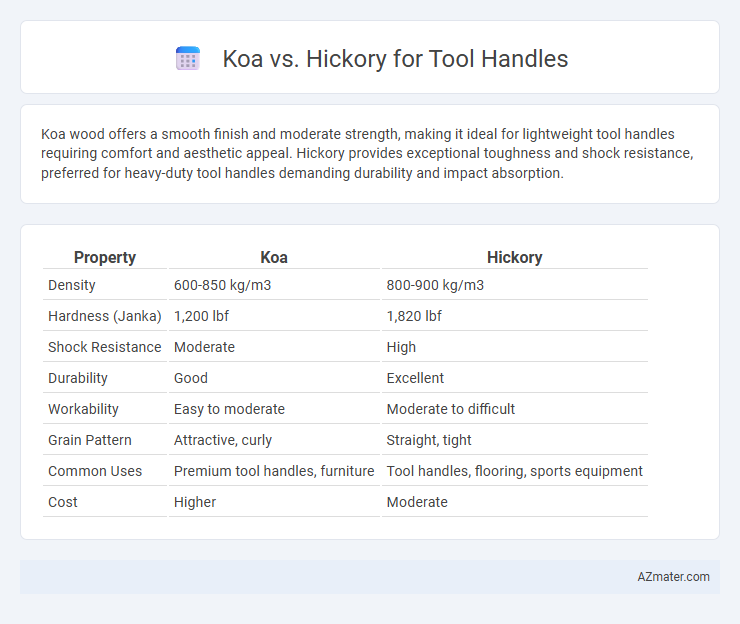Koa wood offers a smooth finish and moderate strength, making it ideal for lightweight tool handles requiring comfort and aesthetic appeal. Hickory provides exceptional toughness and shock resistance, preferred for heavy-duty tool handles demanding durability and impact absorption.
Table of Comparison
| Property | Koa | Hickory |
|---|---|---|
| Density | 600-850 kg/m3 | 800-900 kg/m3 |
| Hardness (Janka) | 1,200 lbf | 1,820 lbf |
| Shock Resistance | Moderate | High |
| Durability | Good | Excellent |
| Workability | Easy to moderate | Moderate to difficult |
| Grain Pattern | Attractive, curly | Straight, tight |
| Common Uses | Premium tool handles, furniture | Tool handles, flooring, sports equipment |
| Cost | Higher | Moderate |
Overview of Koa and Hickory Woods
Koa wood, native to Hawaii, is prized for its rich grain patterns, medium density, and natural resistance to wear, making it a premium choice for aesthetically appealing tool handles. Hickory wood, known for its exceptional strength, shock resistance, and durability, is widely used in tool handles where functional performance and impact absorption are critical. While Koa offers a unique balance of beauty and strength, Hickory excels in toughness and longevity, influencing their selection based on the tool's intended use and ergonomic needs.
Physical Properties Comparison
Koa and Hickory differ significantly in physical properties relevant to tool handles. Koa is moderately dense with a Janka hardness of about 1,200 lbf, providing a balanced combination of strength and shock absorption, while Hickory exhibits higher density and toughness with a Janka hardness around 1,820 lbf, making it more resistant to impact and wear. Hickory's superior tensile strength and resilience make it the preferred choice for high-stress tool handles requiring maximum durability and vibration resistance.
Durability and Strength
Koa and hickory are both popular choices for tool handles due to their durability and strength. Hickory is renowned for its exceptional shock resistance and toughness, making it ideal for heavy-duty tool handles that require impact endurance. Koa offers a balance of strength and aesthetic appeal but generally lacks the same level of resilience as hickory in high-stress applications.
Shock Absorption Qualities
Koa wood offers moderate shock absorption, providing a balance of stiffness and resilience that reduces vibration transfer during tool use. Hickory excels in shock absorption due to its high density and exceptional toughness, making it the preferred choice for heavy-duty tool handles that endure repeated impact. Choosing Hickory over Koa enhances durability and comfort by minimizing user fatigue through superior vibration damping.
Workability and Machining
Koa wood offers excellent workability for tool handles due to its fine, even grain and moderate density, enabling smooth shaping and sanding with minimal effort. Hickory, known for its exceptional hardness and toughness, is more challenging to machine but provides superior impact resistance and durability. While Koa is favored for ease of machining and aesthetic appeal, Hickory excels in demanding applications requiring strength and resistance to wear.
Weight and Balance Factors
Koa wood is lighter and offers a unique balance for tool handles, making it ideal for users seeking a lightweight yet sturdy grip. Hickory is denser and heavier, providing superior shock absorption and durability, favored in tools requiring strength and impact resistance. Weight and balance factors heavily influence handle performance, with koa enhancing maneuverability and hickory ensuring long-lasting stability under heavy use.
Resistance to Moisture and Decay
Koa wood offers moderate resistance to moisture and decay, making it suitable for tool handles used in less humid environments. Hickory excels in durability and has excellent resistance to moisture and decay, providing superior longevity in high-moisture conditions. Both woods are strong, but Hickory's natural resistance makes it a preferred choice for tool handles exposed to harsh or wet conditions.
Cost and Availability
Koa wood, prized for its rich color and strength, is significantly more expensive and less readily available than hickory, which is abundant and cost-effective for tool handles. Hickory's widespread growth in North America ensures steady supply and consistent pricing, making it the preferred choice for durable, budget-friendly tool handles. Koa's limited range primarily in Hawaii contributes to higher costs and limited accessibility, restricting its use to premium or specialty applications.
Environmental Impact
Koa wood, commonly sourced from Hawaii, offers a more sustainable option for tool handles due to responsible forestry practices and its slower growth rate compared to hickory. Hickory, often harvested from North American forests with less stringent conservation efforts, may contribute to deforestation and habitat disruption. Selecting koa supports eco-friendly forestry management, while hickory's availability must be balanced against potential environmental degradation.
Best Applications for Each Wood
Koa wood, prized for its combination of strength and lightweight properties, excels in tool handles requiring fine control and a comfortable grip, such as chisels and carving tools. Hickory offers exceptional shock resistance and durability, making it ideal for heavy-duty tool handles like axes, hammers, and mauls that endure intense impact. Selecting Koa enhances precision and aesthetic appeal, while Hickory provides superior toughness and longevity for demanding applications.

Infographic: Koa vs Hickory for Tool Handle
 azmater.com
azmater.com